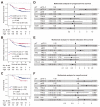Expression Pattern and Prognostic Value of CTLA-4, CD86, and Tumor-Infiltrating Lymphocytes in Rectal Cancer after Neoadjuvant Chemo(radio)therapy
- PMID: 36428666
- PMCID: PMC9688334
- DOI: 10.3390/cancers14225573
Expression Pattern and Prognostic Value of CTLA-4, CD86, and Tumor-Infiltrating Lymphocytes in Rectal Cancer after Neoadjuvant Chemo(radio)therapy
Abstract
The synergistic effect of combining immune checkpoint inhibitors (ICIs) with neoadjuvant chemo(radio)therapy (nCRT) in colorectal cancer is still limited. We aimed to understand the impact of nCRT on the tumor microenvironment and to explore favorable immune markers of this combination. Herein, we investigated the expression of cytotoxic T lymphocyte-associated antigen 4 (CTLA-4), CD86, CD4, and CD8 after nCRT and its association with clinicopathological characteristics. Immunostaining of immune-related molecules was performed in 255 surgically resected specimens from rectal cancer patients treated with nCRT. CD4 and CD8 expression on the tumor (tCD4/CD8), stroma (sCD4/CD8), and invasive front (iCD4/CD8) was evaluated. The expression levels of immune-related molecules were significantly lower in the nCRT-treated group, except for CTLA-4 and sCD8. However, patients with higher sCD8+ cell density and CTLA-4 expression had better progression-free survival (PFS) and distant metastasis-free survival (DMFS). In addition, higher CD86 expression was associated with poorer overall survival (OS). Higher CTLA-4 expression was associated with higher tCD8+ cell density, whereas CD86 expression was correlated with the cell density of t/sCD8. Prognostic analysis confirmed that the relationships between CTLA-4 and DMFS as well as CD86 and OS were significantly correlated in low rather than high CD8+ cell density. Further the combination of CD8+ cell density and CD86 expression was shown to be an independent prognostic factor of OS, whereas the combination of CTLA-4 was not for DMFS. Together, these results demonstrate significant correlations between CD86 expression and t/sCD8+ cell density in rectal cancer after nCRT and could potentially have clinical implications for combining ICIs and nCRT.
Keywords: immune checkpoint molecules; immunotherapy; neoadjuvant chemo(radio)therapy; rectal cancer; tumor-infiltrating lymphocytes.
Conflict of interest statement
The authors declare no conflict of interest.
Figures




Similar articles
-
Tumor-infiltrating lymphocytes, forkhead box P3, programmed death ligand-1, and cytotoxic T lymphocyte-associated antigen-4 expressions before and after neoadjuvant chemoradiation in rectal cancer.Transl Res. 2015 Dec;166(6):721-732.e1. doi: 10.1016/j.trsl.2015.06.019. Epub 2015 Jul 6. Transl Res. 2015. PMID: 26209749
-
High CD8+ tumour-infiltrating lymphocyte density associates with unfavourable prognosis in oesophageal adenocarcinoma following poor response to neoadjuvant chemoradiotherapy.Histopathology. 2021 Aug;79(2):238-251. doi: 10.1111/his.14361. Epub 2021 Apr 27. Histopathology. 2021. PMID: 33660299
-
Pattern of programmed cell death-ligand 1 expression and CD8-positive T-cell infiltration before and after chemoradiotherapy in rectal cancer.Eur J Cancer. 2018 Mar;91:11-20. doi: 10.1016/j.ejca.2017.12.005. Epub 2018 Jan 9. Eur J Cancer. 2018. PMID: 29328976
-
Immune checkpoint proteins (PD-L1 and CTLA-4) in endometrial carcinoma: prognostic role and correlation with CD4+/CD8+ tumor infiltrating lymphocytes (TILs) ratio.J Immunoassay Immunochem. 2022 Mar 4;43(2):192-212. doi: 10.1080/15321819.2021.1981377. Epub 2021 Oct 26. J Immunoassay Immunochem. 2022. PMID: 34697997
-
The implications from the interplay of neoadjuvant chemoradiotherapy and the immune microenvironment in rectal cancer.Future Oncol. 2022 Sep;18(28):3229-3244. doi: 10.2217/fon-2022-0061. Epub 2022 Aug 26. Future Oncol. 2022. PMID: 36017694 Review.
Cited by
-
Dendritic cells: the yin and yang in disease progression.Front Immunol. 2024 Jan 4;14:1321051. doi: 10.3389/fimmu.2023.1321051. eCollection 2023. Front Immunol. 2024. PMID: 38239364 Free PMC article. Review.
-
Immune Response and Immune Checkpoint Molecules in Patients with Rectal Cancer Undergoing Neoadjuvant Chemoradiotherapy: A Review.Curr Issues Mol Biol. 2023 May 22;45(5):4495-4517. doi: 10.3390/cimb45050285. Curr Issues Mol Biol. 2023. PMID: 37232754 Free PMC article. Review.
References
-
- Boland C.R., Thibodeau S.N., Hamilton S.R., Sidransky D., Eshleman J.R., Burt R.W., Meltzer S.J., Rodriguez-Bigas M.A., Fodde R., Ranzani G.N., et al. A National Cancer Institute Workshop on Microsatellite Instability for cancer detection and familial predisposition: Development of international criteria for the determination of microsatellite instability in colorectal cancer. Cancer Res. 1998;58:5248–5257. - PubMed
Grants and funding
LinkOut - more resources
Full Text Sources
Research Materials

